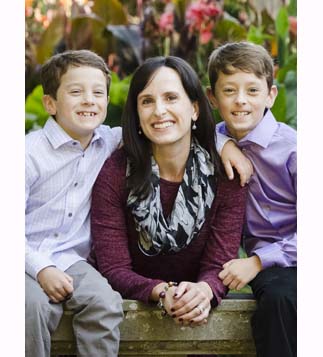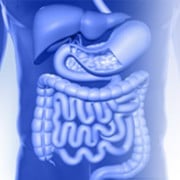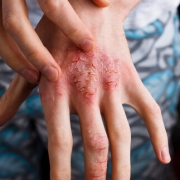Eating Hurts – Could it be Eosinophilic Esophagitis?

Jodi Holland, Registered Dietitian
Jodi Holland is a Registered Dietitian with Pure Nutrition Consulting. She shares nutritional tips and strategies with individuals and families – and with us. Today she offers insight into a condition known as Eosinophilic esophagitis (EoE).
When Eating Hurts
Your little one was diagnosed with Celiac disease. You’ve eliminated all gluten and are meticulous to avoid all possible sources of cross-contamination. But your child continues to have tummy pain, poor growth or is still throwing up often. What’s going on?
Eosinophilic esophagitis (EoE) is a chronic, allergic inflammatory disease of the esophagus. EoE is an emerging disease that is being increasingly diagnosed in children and adults. When eosinophils (a type of white blood cell that helps us to fight off certain infections) accumulate in the esophagus, this can lead to injury and inflammation of the esophagus, plus pain and discomfort.
 Common symptoms of EoE include the following:
Common symptoms of EoE include the following:
- Reflux that does not respond to medication
- Difficulty swallowing
- Nausea and vomiting
- Poor appetite, poor growth or weight loss
- Abdominal or chest pain
- Food impactions (food getting stuck in the esophagus)
Confusingly, some of these symptoms are similar to those of reflux or when a person with Celiac disease consumes gluten. Children with EoE may take a long time to eat, need to drink an increased amount of fluid to “wash food down” and may have a preference for liquid or pureed textures.
It is estimated that 1-4 in 10,000 people in North America are affected with EoE, with a higher incidence seen in males.1 The diagnosis of EoE among children and adults has increased at the same time that rates of food allergies, allergic eczema and rhinitis have also increased in Westernized countries. 2 As well, even though Celiac disease and EoE are separate gastrointestinal disorders, several studies have hypothesized a possible coexistence. 1 Some studies have demonstrated that the prevalence of EoE in people (including children) with Celiac disease is about 10-times that of the general population. 3
How is EoE Diagnosed?
Proper diagnosis of EoE is essential in order for appropriate treatment to commence. EoE is diagnosed after consultation with a gastroenterologist. While the exact cause of EoE is not yet known, it is thought to be caused by an immune response to specific foods, with a possible genetic link. 3
The two main treatments recommended for EoE are nutrition therapy and medication in order to resolve symptoms, prevent disease-related complications (i.e. narrowing of esophagus) and ensure a nutritionally complete intake.
 Common options for nutrition therapy include the following 4 :
Common options for nutrition therapy include the following 4 :
Elemental Diet
- All sources of protein are removed.
- Patient drinks only an amino acid formula.
- Feeding tubes often used.
- Course of treatment
- Amino acid formula is used for 4-6 weeks to induce remission.
- Once remission is achieved, least allergenic foods (i.e. vegetables and fruit) are reintroduced.
- Foods are progressed towards more allergenic foods as tolerated, while maintaining remission.
Empirical Elimination Diet or Six Food Elimination Diet (SFED)
- Eliminate cow’s milk protein, wheat, egg, soy, peanut/tree nuts and fish/shellfish.
- Course of treatment
- Avoid all foods containing these ingredients for 6 weeks.
- Reintroduction of foods begins when remission confirmed.
Directed Elimination Diet
- Foods are removed based on the results of allergy testing.
- Course of treatment
- Avoid identified foods.
For the Parent
EoE is a chronic disease that requires ongoing monitoring and management. Focus on what your child can eat, as opposed to what they cannot, and seek help from a Registered Dietitian for resourceful and creative ways to optimize your child’s intake. Families and healthcare teams need to work together to identify their best management strategy. Once trigger foods are identified, their long-term avoidance is recommended in order to maintain remission.
Jodi Holland is a meal planning pro and an expert on nutrition for families and individuals. From prenatal nutrition to picky eaters to sports nutrition or a specific health condition like Celiac Disease, she can provide you with simple strategies and practical tips to achieve health and balance. Connect with Jodi to heighten your nutrition!
Also by Jodi Holland – Your Gluten-Free Grocery Cart
When Your Fruit Bites Back – Oral Allergy Syndrome
References:
- 1 Mehta and Furuta, Immunol Allergy Clin North Am. 2015 Aug; 35(3): 413–437.
- 2 Wechsler et al, Gastroenterol Clin N Am 2014;43:281-296
- 3 Pellicano et al, 2013 Aug 22;5(9):3329-36.
- 4 Learning On Demand (Dietitians of Canada). (2016). Eosinophilic Esophagitis: Inflammation and elimination [Webinar]. Retrieved from https://www.dietitians.ca/Learn/Distance-Learning/LOD-Player.aspx?guid=da910c45-9d8b-48d7-a3d6-604300ebf52b.














